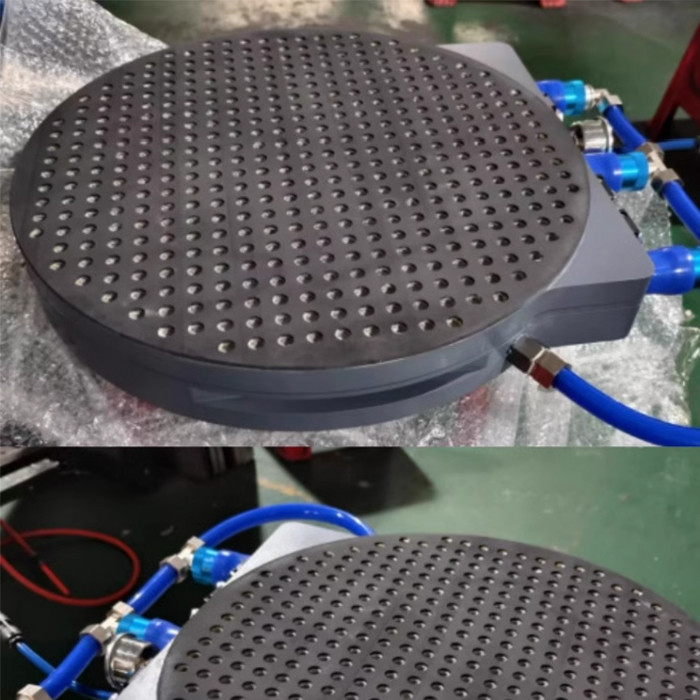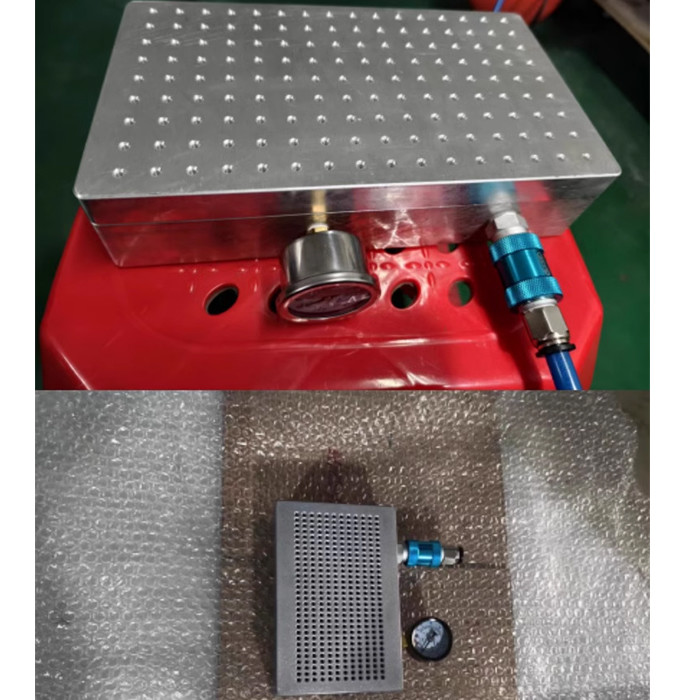2. Working Principle
Vacuum Generation
When the vacuum source is activated, air is rapidly drawn out from
the vacuum chamber and through the channels to the ports on the
clamping surface. This creates a region of low pressure beneath the
workpiece, while the atmospheric pressure above the workpiece
remains constant. The resulting pressure differential exerts a
downward force on the workpiece, pressing it firmly against the
clamping surface.
The strength of the vacuum, measured in units such as Pascals or
Torr, determines the magnitude of the pressure differential and,
consequently, the holding force on the workpiece. The larger the
surface area of the workpiece in contact with the clamping surface
and the higher the vacuum pressure, the greater the holding force.
Adaptability to Different Workpiece Materials
The custom workpiece vacuum chuck is highly adaptable to various
workpiece materials. For smooth - surfaced materials like metals,
the vacuum creates a strong seal, providing a secure hold. The even
distribution of the vacuum force across the clamping surface helps
in compensating for minor surface irregularities. When working with
porous materials such as certain types of plastics or wood, the
vacuum can penetrate through the pores, creating a more intimate
connection between the workpiece and the chuck.
For example, in a horizontal lathe machining a wooden dowel, the
vacuum can seep into the porous structure of the wood, increasing
the holding force. In a vertical lathe machining a large aluminum
plate, the smooth surface of the plate allows for a strong vacuum
seal, ensuring that the plate remains stationary during machining.
3. Advantages in Vertical Lathes
Secure Holding of Large and Heavy Workpieces
Vertical lathes are often used for machining large and heavy
workpieces. The custom vacuum chuck provides a secure hold for such
workpieces. The large - diameter base of the chuck, combined with
the strong vacuum force, can support the weight of the workpiece
and prevent it from moving or vibrating during machining.
For instance, when machining a large - diameter cylinder in a
vertical lathe, the vacuum chuck can hold the cylinder firmly in
place, allowing for precise turning and boring operations. The
ability to hold heavy workpieces securely also reduces the risk of
accidents and damage to the lathe and the workpiece.
Precision Machining
In vertical lathes, precision is crucial, especially when machining
components for industries such as aerospace and automotive. The
vacuum chuck's stable workholding capabilities minimize any
movement or vibration of the workpiece during machining. The
uniform vacuum distribution across the clamping surface ensures
that the machining tools can operate with high precision.
For example, when milling a complex pattern on a large vertical
lathe workpiece, the stable hold provided by the vacuum chuck
allows the milling cutter to follow the programmed path accurately,
resulting in a high - quality finish and tight tolerances.
4. Benefits in Horizontal Lathes
High - Speed Machining
Horizontal lathes are commonly used for high - speed machining
operations. The custom vacuum chuck can withstand the high - speed
rotation of the workpiece. The strong and secure hold on the
workpiece ensures that it remains firmly in place, even at high
spindle speeds.
This enables aggressive machining strategies, such as high - feed
and high - depth - of - cut operations, without the risk of
workpiece slippage. In the manufacturing of small - to - medium -
sized metal components, high - speed machining in horizontal lathes
with the help of the vacuum chuck can significantly increase
productivity and reduce production times.
Versatility in Workpiece Shapes
Horizontal lathes are used to machine a wide variety of workpiece
shapes, from simple cylinders to complex geometries. The custom
vacuum chuck can be customized to hold different workpiece shapes.
Special fixtures can be designed and attached to the clamping
surface to accommodate irregularly shaped workpieces.
For example, when machining a non - circular shaft in a horizontal
lathe, a custom - designed fixture can be used with the vacuum
chuck to hold the shaft securely. The ability to adapt to different
workpiece shapes makes the vacuum chuck a versatile tool for
horizontal lathe operations.
5. Customization Options
Vacuum Pressure Adjustment
The vacuum pressure of the custom workpiece vacuum chuck can be
adjusted to meet the specific requirements of different workpieces
and machining operations. For delicate workpieces or materials that
are easily damaged, a lower vacuum pressure can be applied. For
heavy - duty machining of tough materials, a higher vacuum pressure
can be set.
The adjustment of the vacuum pressure can be done manually using a
pressure regulator or can be automated through the lathe's control
system. In some advanced setups, sensors can be used to monitor the
vacuum pressure and adjust it in real - time based on the machining
process.
Fixture Design
The fixtures used with the vacuum chuck can be customized based on
the workpiece geometry. Specialized fixtures can be designed to
hold workpieces with unique shapes, sizes, or surface
characteristics. These fixtures can be made of different materials,
such as aluminum, steel, or plastic, depending on the requirements
of the machining process.
For example, a fixture can be designed with grooves or protrusions
to fit a specific irregular - shaped workpiece. The fixture can be
attached to the clamping surface of the vacuum chuck using quick -
release mechanisms, allowing for easy installation and removal.
6. Installation and Maintenance
Installation Process
Installing the custom workpiece vacuum chuck on a lathe involves
several steps. First, the base of the chuck needs to be securely
mounted on the lathe's worktable or spindle. This may require the
use of appropriate mounting brackets and fasteners to ensure
stability. The vacuum source, such as a vacuum pump, is then
connected to the vacuum ports on the chuck, and the connections are
checked for leaks.
Once the physical installation is complete, the vacuum system needs
to be calibrated to ensure proper vacuum generation and
distribution. This may involve adjusting the vacuum pressure,
testing the sealing performance of the chuck, and verifying the
functionality of any integrated sensors or controls. In some cases,
the lathe's control system may need to be configured to work in
tandem with the vacuum chuck.
Maintenance Requirements
Maintenance of the custom workpiece vacuum chuck is relatively
straightforward. Regular inspection of the clamping surface for any
signs of wear, damage, or contamination is important. The vacuum
channels and ports should be cleaned periodically to remove any
debris or particles that could block the vacuum flow. The vacuum
pump and associated components should be maintained according to
the manufacturer's instructions, including regular oil changes,
filter replacements, and performance checks.
The seals and gaskets in the vacuum system should be inspected
regularly and replaced if there are any signs of leakage. By
following these maintenance procedures, the custom workpiece vacuum
chuck can maintain its performance and reliability over an extended
period.
7. Conclusion
The custom workpiece vacuum chuck clamping tool is an essential
addition to vertical and horizontal lathes. Its unique design,
working principle, and numerous advantages make it suitable for a
wide range of applications in different industries. Whether it's
achieving precision in high - tech manufacturing or enhancing
productivity in general machining, this clamping tool offers a
reliable and efficient solution. If you are involved in lathe
machining and are looking to improve the performance of your
workholding system, consider investing in a custom workpiece vacuum
chuck. Reach out to our team of experts to explore how this
innovative tool can be customized to meet your specific needs and
take your lathe machining capabilities to the next level.













